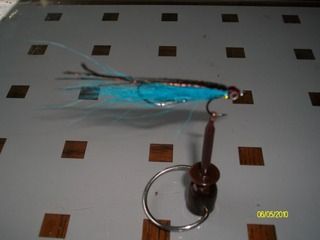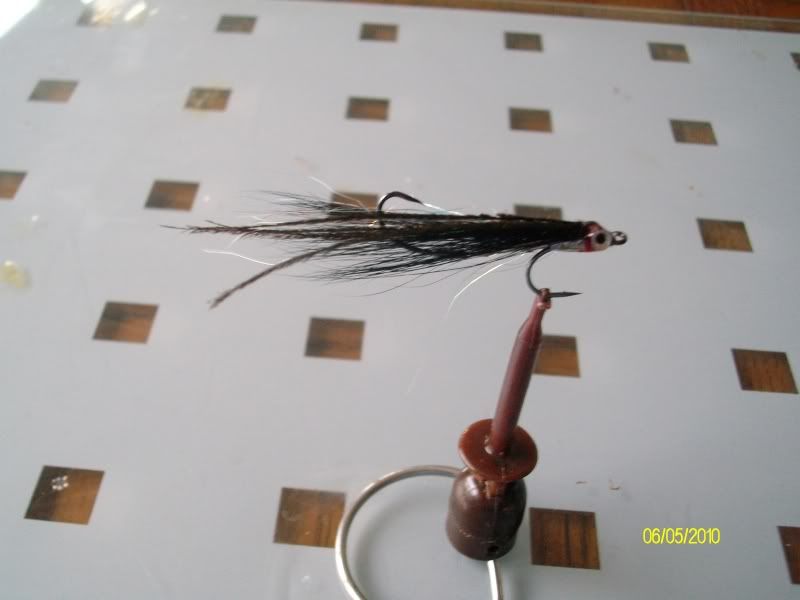Ok, here's another step-by-step of a quick fix for you guys, which I hope you will find of use. This is a simple answer to fish coming short when you're fishing a tube with a long wing, or a dressed single/double with a long wing. It also enables you to convert a standard tube into a stinger, should you find the fish coming short.
The idea originates from a similar method a guide showed me whilst fishing the Rio Grande a couple of years back. We were fishing collie dogs with really long wings, and the hook wasn't really connecting that well. As such, the guide had a loop system where the hook would ride a good way back into the wing, and this solved the problem, but the loop wasn't very rigid and would often double back. So, this is another version, and a way of solving the same problem, whilst also creating a superb, quick and easy stinger mount.
Step 1.
First, take a length of heavy nylon – I tend to almost exclusively use amnesia nowadays in black, red or clear and in 30lbs and 40lbs. Here I have used 30lbs. You will need some 20cm. Place a straight eye, wide gape single in the vice - the size of the hook will vary according to the size of the double used. As a rule use a single the same size as the double, or one smaller. Take the nylon ends through the eye of the hook, one in each direction.

Step 2.
Pull on both ends of the nylon so that you have them at even length, drawing the loop up tight to the eye of the hook. Adjust the nylon loop by the eye of the hook so that it rests slightly behind the eye, rather than to the side. Make sure that the nylon is pulled in as tight as possible.

Step 3.
Turn the vice towards you and start overlapping the nylon section to create twists. Splay the nylon lengths to draw in the twists into tight turns. After a 3cm or so length is achieved throw in a half hitch to hold.

Step 4.
Next measure up some 3mm diameter shrink tubing – you can use any colour. Measure it so that it would run 1/3rd of the way up the shank of the hook, ending where you put the half hitch in the nylon.

Step 5.
Slide the shrink tubing over the nylon ends, slowly teasing it up and over the twists, eventually drawing onto the eye. Stop when you see the half hitch appear.


Step 6.
Take the hook out of the vice and run the shrink tubing over a flame. Do this quickly and avoid holding it over one spot for too long. When the full length has shrunk you will see the twists show through. Place the hook back in the vice and pull the nylon ends tight. This will give you a perfectly straight mount once the tubing cools and sets.


Step 7.
You may now remove the half hitch, as the snugness of the shrink tubing will hold everything in place.

Step 8.
Take either a partridge BMD if using as a tube fly extension mount or a partridge HND if using as a stinger mount. Start by tying on just where the tubing ends then run the thread down the length of the shank, securing both lengths of nylon. Cut one nylon section some 2mm short of the eye, then loop the other length through the eye and back underneath the hook, running your thread back down the shank, securing this section in place.


Step 9.
If you are making an extension mount for a tube then you would now whip finish and superglue the length of the shank, securing everything in place. If, however, you are making a secret weapon then the process continues. You would, however, still superglue at this juncture, to secure the nylon etc.

Step 10.
Tie in some tinsel – preferably when the superglue is still wet as this will secure the tinsel and take away the need of ribbing.

Step 11.
Tie in the wing – I’ve used Russian black squirrel. Then add some flash – some 4 strands of peacock black krinkle mirror flash.


Step 12.
Tie in a black hen hackle, one with fibres that will protrude a long way down the body, similar to a schlappen affect. Brush down the length of the feather with your fingers before winding on the hackle, releasing the individual fibres so that they don’t clump when winding, which the soft, webby hen and schlappen hackles are prone to do. Wind on the full length, then tie off. Brush the fibres back over the body and tie off. Whip finish, superglue or varnish, job done.


Step 13.
The tube fly version.


Hope that was easy enough to follow and that it was of use to some of you.
Tightlines,
TT.
The idea originates from a similar method a guide showed me whilst fishing the Rio Grande a couple of years back. We were fishing collie dogs with really long wings, and the hook wasn't really connecting that well. As such, the guide had a loop system where the hook would ride a good way back into the wing, and this solved the problem, but the loop wasn't very rigid and would often double back. So, this is another version, and a way of solving the same problem, whilst also creating a superb, quick and easy stinger mount.
Step 1.
First, take a length of heavy nylon – I tend to almost exclusively use amnesia nowadays in black, red or clear and in 30lbs and 40lbs. Here I have used 30lbs. You will need some 20cm. Place a straight eye, wide gape single in the vice - the size of the hook will vary according to the size of the double used. As a rule use a single the same size as the double, or one smaller. Take the nylon ends through the eye of the hook, one in each direction.

Step 2.
Pull on both ends of the nylon so that you have them at even length, drawing the loop up tight to the eye of the hook. Adjust the nylon loop by the eye of the hook so that it rests slightly behind the eye, rather than to the side. Make sure that the nylon is pulled in as tight as possible.

Step 3.
Turn the vice towards you and start overlapping the nylon section to create twists. Splay the nylon lengths to draw in the twists into tight turns. After a 3cm or so length is achieved throw in a half hitch to hold.

Step 4.
Next measure up some 3mm diameter shrink tubing – you can use any colour. Measure it so that it would run 1/3rd of the way up the shank of the hook, ending where you put the half hitch in the nylon.

Step 5.
Slide the shrink tubing over the nylon ends, slowly teasing it up and over the twists, eventually drawing onto the eye. Stop when you see the half hitch appear.


Step 6.
Take the hook out of the vice and run the shrink tubing over a flame. Do this quickly and avoid holding it over one spot for too long. When the full length has shrunk you will see the twists show through. Place the hook back in the vice and pull the nylon ends tight. This will give you a perfectly straight mount once the tubing cools and sets.


Step 7.
You may now remove the half hitch, as the snugness of the shrink tubing will hold everything in place.

Step 8.
Take either a partridge BMD if using as a tube fly extension mount or a partridge HND if using as a stinger mount. Start by tying on just where the tubing ends then run the thread down the length of the shank, securing both lengths of nylon. Cut one nylon section some 2mm short of the eye, then loop the other length through the eye and back underneath the hook, running your thread back down the shank, securing this section in place.


Step 9.
If you are making an extension mount for a tube then you would now whip finish and superglue the length of the shank, securing everything in place. If, however, you are making a secret weapon then the process continues. You would, however, still superglue at this juncture, to secure the nylon etc.

Step 10.
Tie in some tinsel – preferably when the superglue is still wet as this will secure the tinsel and take away the need of ribbing.

Step 11.
Tie in the wing – I’ve used Russian black squirrel. Then add some flash – some 4 strands of peacock black krinkle mirror flash.


Step 12.
Tie in a black hen hackle, one with fibres that will protrude a long way down the body, similar to a schlappen affect. Brush down the length of the feather with your fingers before winding on the hackle, releasing the individual fibres so that they don’t clump when winding, which the soft, webby hen and schlappen hackles are prone to do. Wind on the full length, then tie off. Brush the fibres back over the body and tie off. Whip finish, superglue or varnish, job done.


Step 13.
The tube fly version.


Hope that was easy enough to follow and that it was of use to some of you.
Tightlines,
TT.

 Looking forward to showing you around. Hope to see you on the riverbank soon mate.
Looking forward to showing you around. Hope to see you on the riverbank soon mate.

Comment